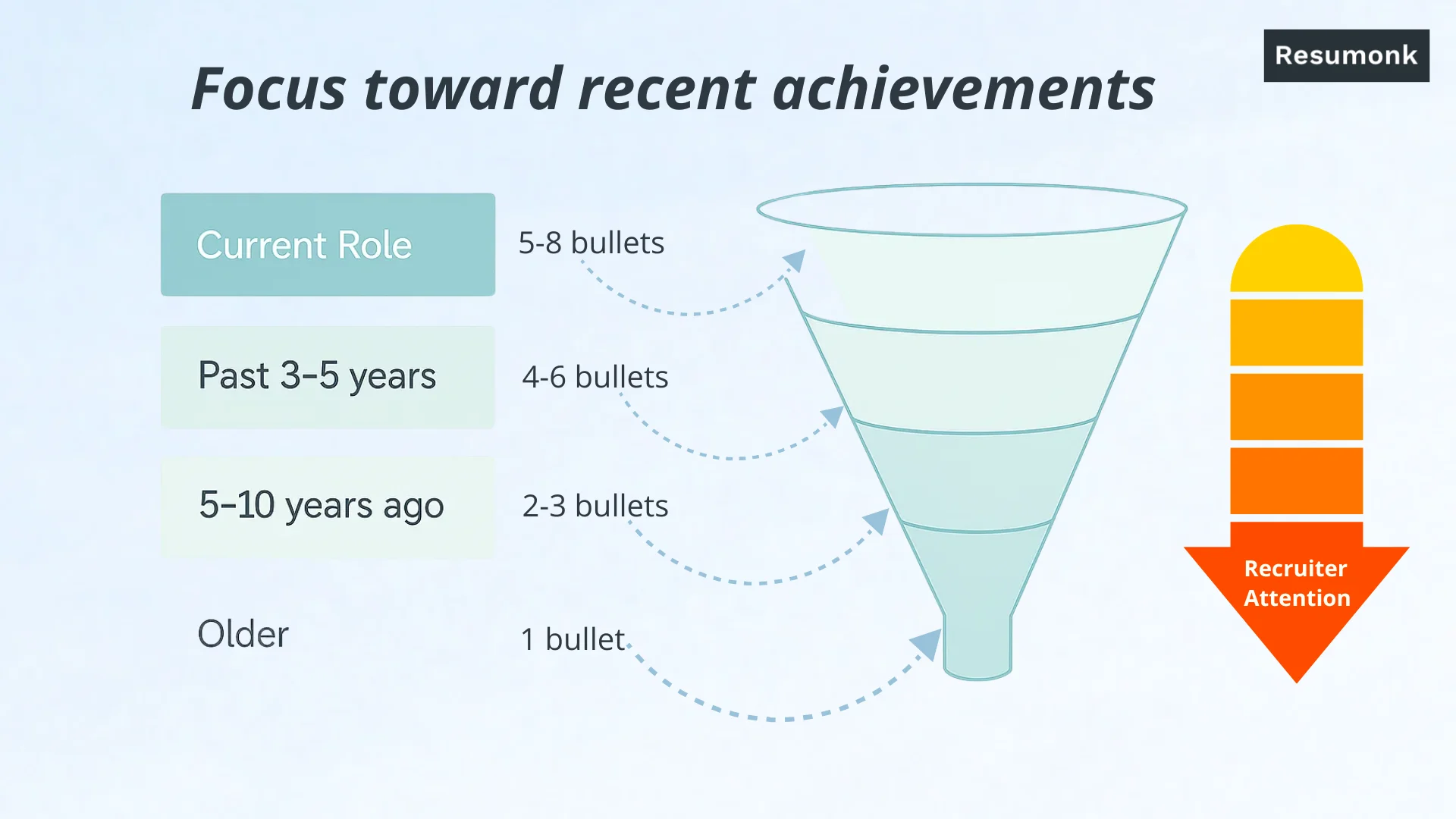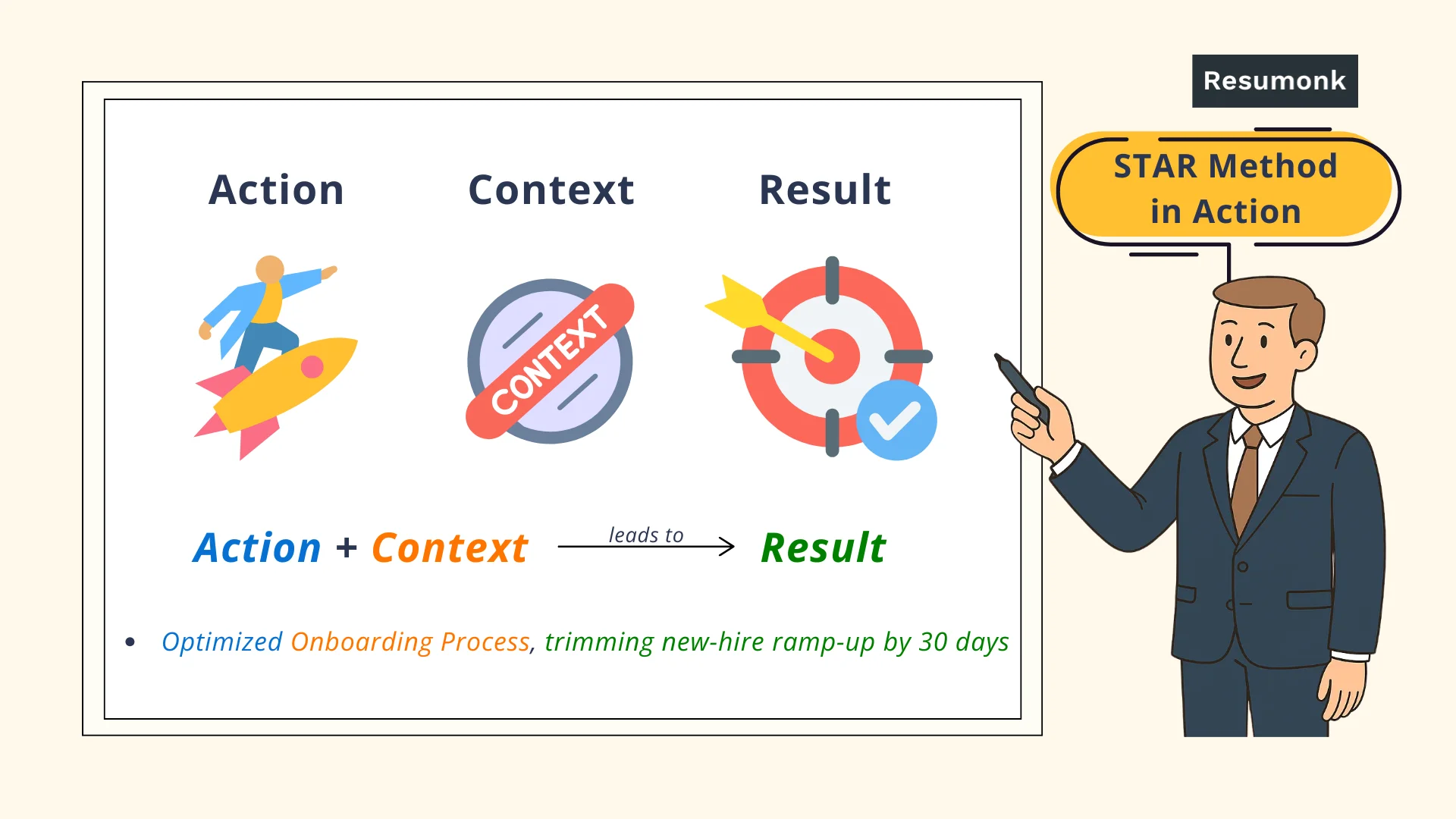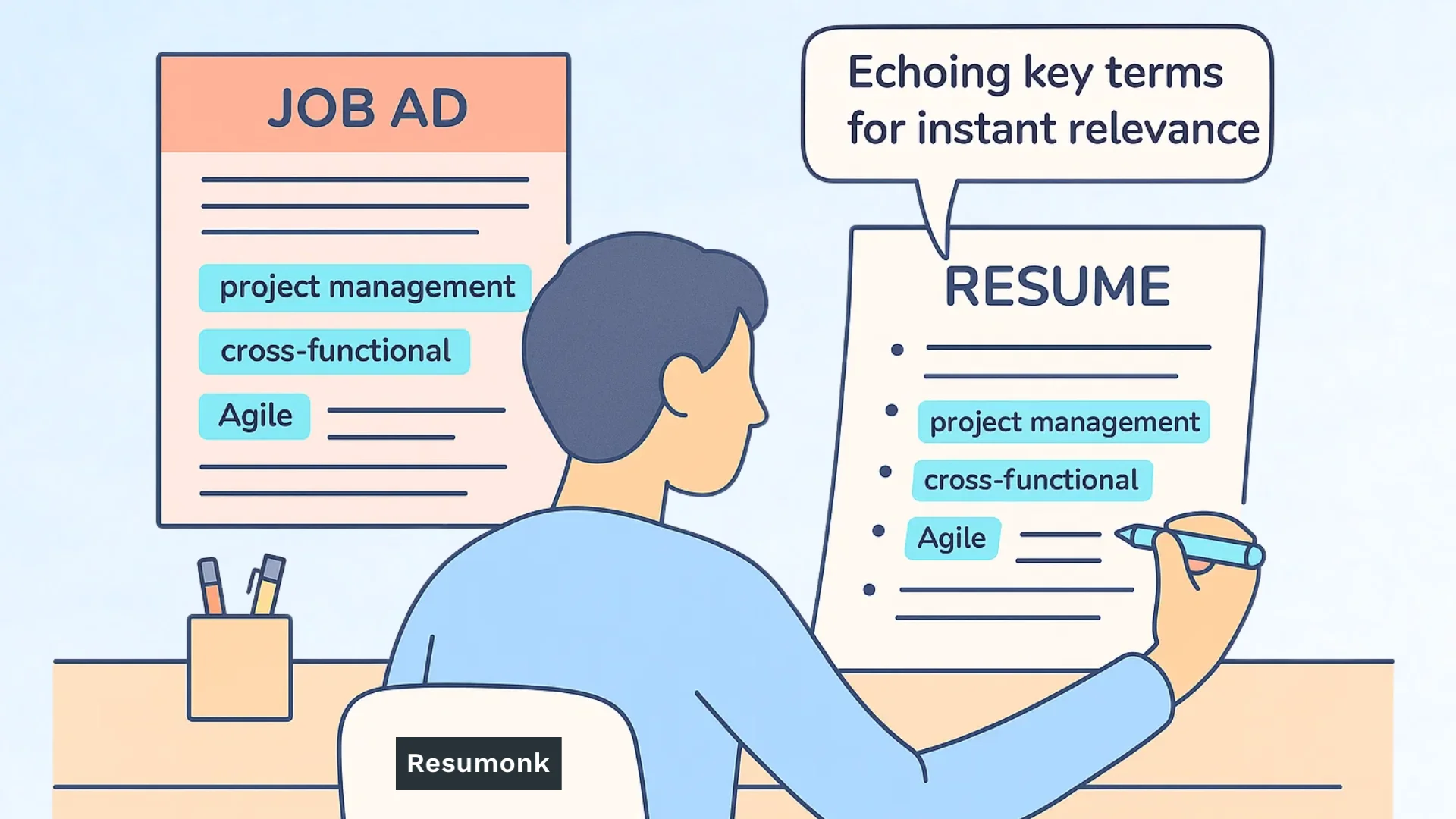
Every day, thousands of perfectly qualified candidates get rejected not because they lack skills, but because their resume bullet points commit the cardinal sin of being boring. While you're busy listing every responsibility you've ever had, your competition is crafting achievement-focused bullets that make hiring managers sit up and take notice.
Just imagine this for a second - somewhere, a hiring manager is scrolling through a sea of resumes, eyes glazing over endless lists of “responsible for,” “assisted with,” and “managed.” Suddenly, a bullet point leaps off the page - quantified, punchy, and packed with proof of impact. In that moment, a candidate vaults from forgettable to first-choice, all because they knew how to turn bland duties into compelling achievements.
Yet, most job seekers treat these bullets like an afterthought, missing the chance to show why their work mattered. This guide will teach you how to craft bullet points that grab attention, prove your value, and make recruiters actually want to call you back.
We’ll break down the science behind what works, reveal how many bullets you really need, and give you frameworks, examples, and advanced strategies to help your resume stand out - no exaggeration required.
Think of bullet points as the espresso shots of a resume - short, strong, and engineered for instant impact.
That is - if they're written correctly!
A resume bullet point is a one- or two-line statement that spotlights a single achievement, rather than listing a duty.
By opening with a verb and closing with a concrete result, each bullet tells hiring managers what you did and why it mattered, in language their brains can process at a glance.
University career centers even urge students to ditch paragraph summaries and “write content using bullet points instead of prose” for readability.
Across the Atlantic, you’ll notice culture in the punctuation.
North-American résumés rely on compact bullets (one or two lines) to prove fit fast, while UK and Australian CVs tolerate longer bullets or brief paragraphs because their multi-page format is expected.
Indeed’s global guide notes that U.S. recruiters equate brevity with focus, whereas UK hiring managers expect fuller context in an academic-style CV.
In Australia, SEEK reminds applicants that CVs “include detailed descriptions” while résumés “use concise bullet points” to save space.
Eye-tracking reveals recruiters scan in an F-shaped pattern, anchoring first on job titles and then flitting down the left margin - exactly where bullet points live.
Because brains privilege chunks over walls of text, a punchy list triggers faster pattern matching and dopamine-laced “relevance recognition.”
Prospects UK even advises bullets to “let employers skim and pick out important information quickly.”
An academic field experiment tracking nearly half a million jobseekers showed that resumes enhanced with concise, well-structured writing (yes, bullet points) boosted hiring odds by 8 percent. (van Inwegen et al., 2023.)
When every callback metric matters, bullet quality isn’t fluff - it’s a statistically proven lever.
Too few bullets undersell you, too many bury your best wins.
Aim for a “just right” count that guides the recruiter’s eyes without overwhelming them.
Career advisors converge on a sweet spot of three to five bullets per recent role.
This range supplies enough data to prove impact while remaining skimmable.

Think of it as the résumé equivalent of a balanced meal: protein, veggies, carbs - no empty-calorie fluff.
Here’s a quick cheat sheet before you start counting:
Recent, mission-critical roles deserve the upper end of the range; decade-old summer jobs might earn a single line.
Trim bullets ruthlessly for positions that don’t serve the narrative of the target role.
Business Insider warns that bloated résumés “are difficult for employers to navigate,” so curate before you embellish.
If your resume spills past two pages, you don’t have a bullet problem, you have a focus problem.
Keep total bullets under 25 for most professionals; executives with lengthy track records can stretch to 35 across two pages, provided each line adds measurable value.
The rule of eye-rest: if any page looks like a perforated wallpaper strip, cut.
Now that you know how many, let’s master how. Below are field-tested frameworks to turn bland tasks into brag-worthy sound bites.
Situation, Task, Action, Result (STAR) isn’t just for interviews. Compress the framework into two lines:
1. open with the Action you took,
2. hint at the Situation/Task for context,
3. and finish with the Result.
Columbia University even teaches students to draft bullets by “using the STAR method to develop strong statements.”
Example: “Optimized onboarding process, trimming average new-hire ramp-up by 30 days.”

Flabby verbs are resume kryptonite. Swap “helped with reports” for “spearheaded quarterly reporting.” Below are power verbs to keep in your holster:
Need more? The Muse’s 185-verb list is a gold mine.
Metrics turn claims into proof. If hard numbers elude you, estimate using before-and-after benchmarks or ratios (e.g., “cut processing time by ~15 hours/week”).
LinkedIn’s career experts confirm that data “significantly enhances a resume’s effectiveness.”
Cap bullets at one to two lines and 20–25 words. Indeed advises “limit each bullet point to two lines” so hiring managers absorb key facts at a glance.
Maintain consistent punctuation and spacing for a polished, psychologically pleasing visual rhythm.
❌ Before: “Responsible for managing social media.”
✅ After: “Revived brand presence by launching data-driven campaigns that grew followers 140% in six months.”
Not every win comes with a ticker-tape of metrics.
If you improved morale or simplified a convoluted process, the CFO may not have slapped a percentage on it - but recruiters still need to feel the impact.
This section will help you translate those “you had to be there” victories into résumé gold.
Start by listing moments when a colleague said, “Thanks to you, this is easier now.”
Think smoother onboarding, restored client trust, or rescuing a project from the brink.
Indeed’s guide to accomplishment statements reminds us that qualitative wins such as improving collaboration carry as much weight as numbers.
PS: You should maintain a running “brag doc” so these subtle triumphs don’t vanish into the past.
Borrow the vocabulary of impact studies - words like streamlined, revitalized, pioneered.
Purdue OWL advises opening each bullet with a muscular verb to make a striking first impression.
“Mentored a five-member cross-functional team.”“Redesigned intake workflow for clearer accountability.”“Elevated client satisfaction through proactive issue-tracking.”Soft skills are only “soft” until they decide the promotion.
SHRM notes that hiring managers actively scan for communication, adaptability and collaboration cues.
Translate people-centric wins into action: “Facilitated weekly retros that untangled inter-team bottlenecks.”
Forbes confirms that such achievement-focused phrasing beats dry duty lists every time.
Here are some more generic examples:
"Revitalized onboarding handbook, cutting new-hire confusion despite no formal KPI attached.""Re-established trust with a flagship client after a service outage through weekly progress briefings.""Streamlined file-sharing taxonomy, enabling teams to find assets in seconds rather than minutes."No two careers speak the same dialect. Below is our quick-start phrasebook to make sure your bullets sound fluent in the language of your field and market.
Tech recruiters want to see cause-and-effect, not code-counting contests.
The Ladders recommends showcasing scripts that shaved processing time by 30% to prove engineering ROI. Stack Overflow’s hiring blog adds that bullet brevity must survive the recruiter’s “first-scan” filter.
Example: “Engineered CI/CD pipeline that trimmed release cycles from weekly to daily.”
UK hiring panels tolerate longer CV bullets because the multi-page format is expected, per the National Careers Service guidance.
Australian recruiters at SEEK, however, push for concise résumé bullets to respect their one-to-two-page norm.
In North America, the three-to-five-bullet rule still reigns, according to CareerFoundry’s 2025 software-engineer guide.
At the top of the org chart, your bullets must echo strategy over task.
Forbes warns that executive résumés packed with minutiae dilute perceived leadership. Lead with scale cues - budget size, head-count authority - and finish with market impact:
“Steered $50 M portfolio to record 9% EBIT uplift.”
If your experience is lighter than your enthusiasm, lean on internships, class projects and volunteer gigs.
Indeed lists teamwork, detail orientation and multitasking as standout skills for early-career applicants.
Frame each bullet with transferable verbs:
“Coordinated fundraising event attracting 200 + attendees, showcasing project-management aptitude.”
Here's a comparison table for quick example reference:
Bullet points can fire blanks if you’re not careful. Let’s defuse the four most common misfires I see while reviewing résumés over my morning coffee.
Listing duties (“Responsible for filing invoices”) tells nothing about impact. Forbes flags this as a top résumé red flag because hiring managers hire results, not tasks.
Flip the script: “Streamlined invoice system, cutting payment cycle by two days.”
According to Monster, bullets leap off the page when they begin with a confident, active voice.
Ditch phrases like “various,” “helped,” or “responsible for.”
Purdue OWL cautions that bullets should ideally stay to one line and keep punctuation uniform.
Pick either periods or no periods - then commit like it’s a marriage vow.
Too much detail overwhelms; too little feels hollow.
We'll suggest focusing on scan-friendly snippets that showcase measurable or clearly described outcomes.
Aim for Goldilocks depth: enough to intrigue, not enough to fatigue.
Before and after examples:
Below are “copy-paste-then-personalize” bullet banks for four common job families. We drafted each line to show decisive verbs, a hint of context, and a clear outcome - so you can see the formula in action and mirror it for your own wins.
Cornell’s career hub reminds us that recruiters linger on the top third of each section, so opening bullets must be your mic-drop moments.
Think revenue, reach, and relationships - then quantify whenever possible:
"Generated $1.2 M in new pipeline by launching a data-driven LinkedIn outreach cadence.""Expanded regional market share from 18% to 26% in 12 months through localized influencer campaigns.""Negotiated enterprise contracts worth $750 K, shortening average sales cycle by three weeks.""Designed SEO strategy that lifted organic traffic 60% YoY and secured 15 top-three SERP spots.""Revitalized dormant email list, achieving 32% open rate and $92 K upsell revenue in Q1.""Mentored four junior reps, two of whom exceeded quota by >10% within their first quarter.""Introduced referral program responsible for 14% of net-new leads in FY 2024.""Presented weekly trend briefings that informed executive pricing pivots, preserving 6-point margin."Hiring managers for leadership roles scrutinize scope and strategy, Harvard Business Review notes.
"Directed 28-person cross-functional team delivering $4M SaaS product six weeks ahead of schedule.""Reduced voluntary turnover from 12% to 4% by rolling out mentorship and stay-interview programs.""Re-engineered quarterly OKR process, boosting goal attainment by 19% across three departments.""Secured $3.5 M capital allocation after crafting board-level business case for market expansion.""Championed DEI hiring roadmap that raised under-represented talent representation to 42%.""Negotiated vendor contracts that cut software spend $120 K annually without sacrificing features.""Instituted agile ceremonies, trimming average sprint spillover by 35%.""Spearheaded crisis-response task force that protected 98% customer retention during outage."Stack Overflow’s hiring blog stresses that tech bullets must reveal measurable engineering ROI, not just tech stacks.
"Built Kubernetes-based micro-services, reducing deployment time from 90 minutes to 7 minutes.""Automated regression tests covering 92% code, slashing escaped-defect rate by 64%.""Refactored payment gateway in Go, supporting 3× traffic without latency spikes (<200 ms P95).""Integrated SOC 2-compliant logging that cut incident root-cause analysis from two days to four hours.""Optimized SQL queries, trimming monthly AWS RDS costs by $14 K.""Orchestrated public GraphQL API launch servicing 1.1 B requests in first quarter post-release.""Guided two interns who later achieved full-time conversion with “exceeds” ratings.""Drafted engineering playbook adopted by seven squads, standardizing CI/CD pipelines."Administrative excellence often shows through efficiency metrics and relationship management. Indeed lists organization and attention to detail among the top transferable skills employers crave.
Streamlined travel-booking workflow, saving executives 20 hours annually and 12% in airfare costs.Coordinated 40-speaker virtual summit with 1,300 attendees and 96% satisfaction rating.Digitized records archive of 7,000+ files, cutting retrieval time from days to minutes.Negotiated office-supply contracts, reducing expenses by $9,800 over 18 months.Managed inbox triage, clearing daily backlog and sustaining <4-hour first-response SLA.Implemented color-coded calendaring system that eliminated double-booking incidents.Drafted customer-service scripts that raised first-call resolution to 88%.Produced weekly KPI dashboards for leadership, improving decision-making speed by 15%.Resumonk’s AI Resume Builder analyzes your role and suggests industry-specific verbs - so you can focus on the interview that follows.
Try it now!
Great bullets age quickly if they’re generic.
Below are strategies to keep each line laser-targeted, battle-tested, and future-ready so recruiters can’t help but schedule that call.
Start by highlighting verbs and nouns in the job posting, then echo them sparingly in your bullets - to hit instant relevance.

Harvard Business Review warns that failure to customize is a top mistake candidates make. Cornell’s research shows recruiters skim mainly the first three bullets under each role, so front-load keywords there.
Think of your résumé as a product and run A/B tests: submit two versions with subtle bullet tweaks to separate but similar roles and track response rates.
Business Insider’s talent chief echoes the importance of continuous updates as markets shift.
Storytelling sells: frame a mini-narrative by pairing a challenge with your decisive action and a measurable or descriptive win.
Forbes’ 2025 skills list urges candidates to weave customer orientation and strategic thinking into achievements for stronger resonance.
Glassdoor’s resume-templates study further shows that visually consistent bullets outperform dense paragraphs in recruiter click-through tests.
Prioritize transferable skills - communication, adaptability, analytical thinking - that persist across roles, says the U.S. Bureau of Labor Statistics.
Regularly refresh bullets with new certifications or cross-functional projects to signal agility.
Mastering resume bullet points isn’t just about getting noticed - it’s about proving you’re the candidate who delivers real results.
When you combine achievement-driven bullets with a professional, tailored resume, you give yourself a genuine edge in today’s competitive market.
Ready to transform your resume and land more interviews?
Try Resumonk now and see how the right tools can elevate your job search from ordinary to outstanding.